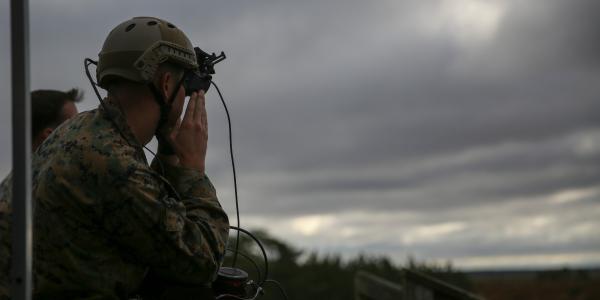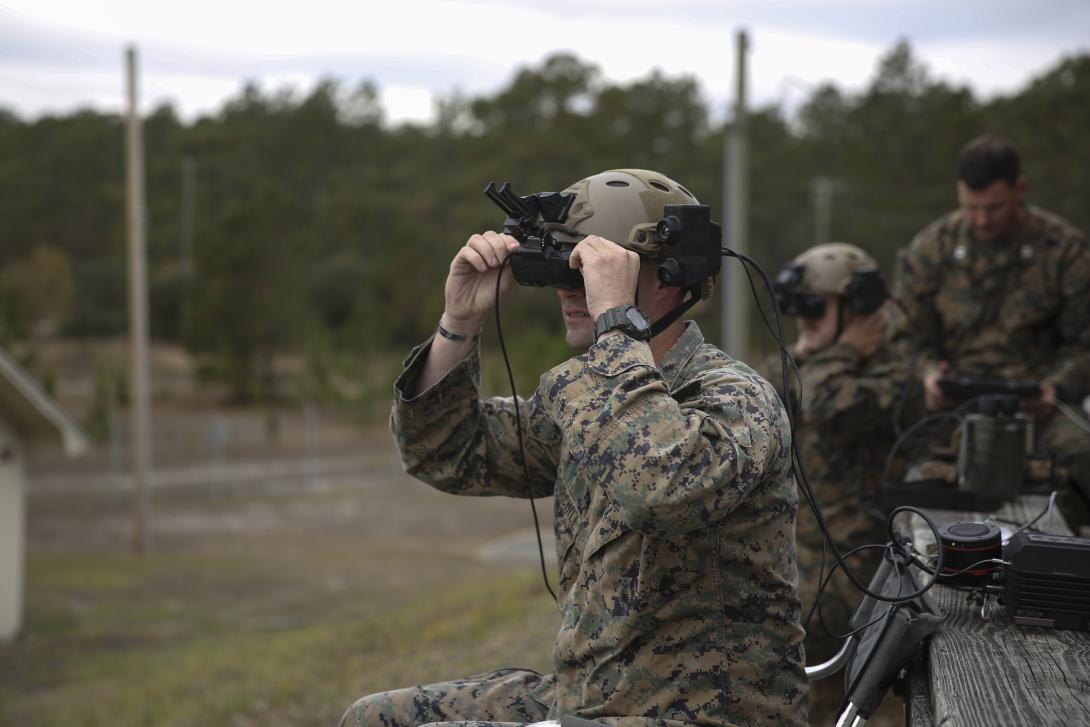Marines Train to Call for Live Fire, Virtually
There is a huge difference for combat troops between being told a mortar has destroyed their command outpost and seeing the destruction firsthand. Certainly, blowing things up comes with a variety of risks and costs. This is one key reason that the U.S. Defense Department has turned to augmented reality technologies for many of its operational tasks.
The Office of Naval Research (ONR), for example, has adapted Microsoft’s multipurpose HoloLens augmented reality (AR) headset for military training. It has militarized what the manufacturer describes as “the first self-contained holographic computer enabling you to engage with your digital content and interact with holograms in the world around you.”
The ONR created its comprehensive Augmented Immersive Team Training (AITT) system that pairs the technology with a laptop, software, battery pack and quadcopters to support forward-observer training in live field environments. Researchers deployed the technology in November with the Spartans, a Marine Corps unit from the 2nd Battalion, 6th Marine Regiment (2/6), 2nd Marine Division, for an annual training exercise at Camp Lejeune, North Carolina.
“We are working with 2/6 to develop a suite of new training tools that are easy to implement, tailorable to Marines’ needs and include the ability to assess decision-making skills,” says Peter Squire, a program officer in the ONR’s Human Performance Training and Education office.
The test was a hit and drummed up excitement about the system, letting leaders of small infantry units rehearse various simulated battlefield missions and quickly witness the results. “The AITT and the HoloLens are fantastic technologies and are very good for training,” says 2nd Lt. Julius Melero, USMC, 2/6 assistant operations officer.
For starters, with the training environment now coming to them, Marines gain more training time than they otherwise would have if they had to travel away from their home base, he says. “These technologies allow us to gain experience in garrison, which allows us to extend our field time,” Lt. Melero says.
Typically, infantrymen split their training time, with 30 percent in the field and the remainder back home, or in garrison. It is during the latter that they are “often not doing a whole lot,” Lt. Melero states. “The point of these technologies is to leverage that white space to allow us to extend the field and the learning and experience we get from it. The point of the technology, and our use of it, is to develop the greatest decision makers in the world.”
AITT enhances force-on-force training—the term used when one side plays the enemy—for call-for-fire and close-air support. The system mitigates training shortcomings, such as not being able to see the battlefield effects of munitions explosions. AITT relies on AR to bridge such gaps and combines virtual information with a real-world view, making the training much more realistic than just having someone shout out that opposing forces called in an artillery shot.
The platform provides lifelike virtual elements, including weapons effects on targets from mortars, artillery and aircraft. The images appear in head-worn displays or in simulated tactical training equipment, such as binoculars. “Depending on how good the collect used to build the 3-D terrain was, the HoloLens can have amazing fidelity to the actual terrain,” Lt. Melero reports.
During their exercise, the Marines “could use [the AITT system] to see what windows threatened a certain avenue of approach, where walls were low, making them the best place to cross over, where the best place to take a rocket shot into a building was. The HoloLens is so effective, we have made a [combat operations center] planning kit and take it to the field every time,” he says.
For its war-gaming software program of record, the Corps contracted with Bohemia Interactive Simulations to use Virtual Battlespace 3. While the controls are not clearly intuitive for all users, it does not take much to rectify that problem, Lt. Melero explains. “It doesn’t take very long to learn how to use them if you take the effort to do so,” he says.
The system enhances a product that has grown out of favor with some Marines. “Every time we go to the field, we wear ITESS,” he says of the Instrumented Tactical Engagement Simulation System—basically, the Marine Corps version of tactical laser tag. “Usually, ITESS is used to determine who shot [whom]. ITESS is very bad at this and so units don’t want to use it.” At least, they do not care for it when it is applied by itself, he emphasizes.
During the November exercise dubbed Spartan Week, the Marines paired ITESS with the war-gaming software I-TDG, or Interactive Tactical Decision Game. “We recently were even able to input ITESS data into I-TDG so we can watch the battle play out on the actual map the commanders planned on. The technology is definitely worth the investment,” Lt. Melero says. “[The technology] is more time. It is more effort. But at the end of the day, it leads us to be better, more effective and deadlier infantrymen.”
The technology makes the impossible possible. “Imagine being on a ship and having 3-D imagery produced from drone footage of the objective you are going to raid,” he summarizes. “You can see avenues of approach, egress route, overwatch positions, etc. Your Marines can become familiar with the objective area before they ever see it in real life. Sure, you could do it over a terrain model or [gridded reference graphics], but from those, it will be doubtful you can actually see how many windows you have to worry about as you move down a particular road or tell with certainty where a defilade is.”






Comment
I'm interested in AR, VR, XR
I'm interested in AR, VR, XR articles...
Comments